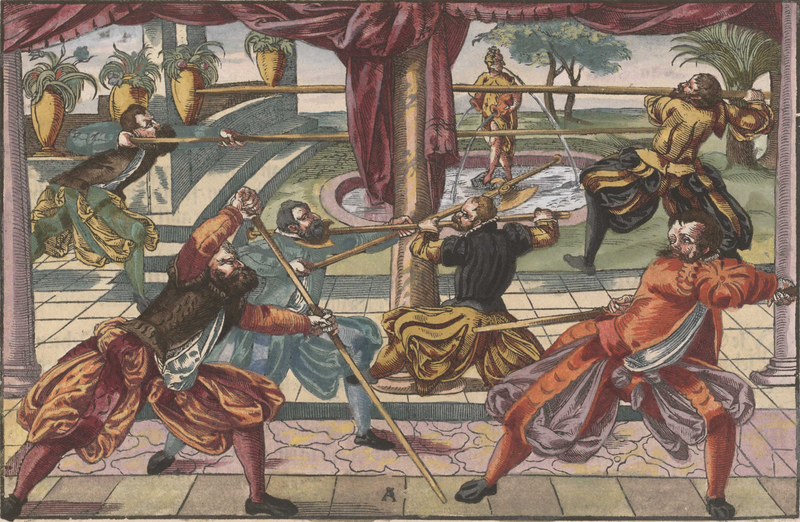Yeah, there is a fierce debate about how common they were, with the bottom line once again being "we don't really know". It may well be they were used as rank insignia in some cases at least, but these are the details that aren't really elaborated on in medieval sources.
I did both, though I mostly stick to European these days. My favourite spear guard is stolen straight from Tai Chi, though.
Eastern issues
The katas, forms, whatever of eastern style of teaching MAs are meant to be a technique syllabus. You go through the sequence once and have all the things your style says you should be able to do with that weapon.
What they aren't is representative of the application. Just because you have a 50/50 ratio of stabs and strikes in spear form doesn't mean you will ahve that ratio in application. A lot of the techniques in the forms are meant to be used in specific cases only, if you see an opening, not as a general thing.
A good way to think about this is to imagine Fiore's blade grabs - if you had a form with all of his giocco largo techniques, you'd have ~20 techniques in total, two of which use blade grabs (and several more for stepping on blade and grabbing opposing hilt). That gives you a ratio of 1 in 10 for grabbing the blade, even though we only rarely see it done in practice.
Finally, tassel doesn't help you. It just... doesn't distract at all. If you are fighting someone, especially with a polearm, you watch him as a whole, you can't tunnel vision onto just the tip of his spears. Where his arms and legs are is just as important. And a spear is a rather large and visible object in the first place.
Western issues
You can't learn a European spear style by looking up a spear chapter in a treatise and study that. To take Fiore as an example, by the time he gets to the spear, he already went through grappling, dagger, sword in one and two hands, sword in armor and pollaxe in armor - and the techniques from previous steps are to be used where applicable. He explicitly tells us so several times.
He then gives you a handful of examples, but the meaning is clear - look at what is in sword section and apply it where you can. More than that, sword section guards are also used in pollaxe section, so you need to look at that as well.We are three masters using spear guards that are closely related to the sword guards.
- Fiore on spear guards, ~1400
As for slashes/strikes and pool-cuing, well, let's listen to the first thing Fiore tells us about how to fight with a spear:
This literally tells you to use pool-cuing and switch up the targets so that your opponent can't defend easily.The extended lance which is used in hand;
The more it is extended, the less it deceives.
This is a bit more arcane, but we know from the past usage that when Fiore says "strike", he means both a cut and a thrust, whatever is applicable in your position. "With a step and a beat", on the other hand, means you should cut into the opposing weapon to defend yourself.Six Masters stand in guard with it,
And with a step and a beat, they suddenly strike,
Both from the right side and from the left (for certain):
The beat is made to the side and not up;
And the beat wants to be one arm's length on the lance,
And whoever goes against it will make such a failure.
Slashes aren't directly addressed by Fiore, not even with swords. The most likely explanation is that he considers them mostly interchangable with cuts.
This comes a bit later, and explicitly tells us to use a strike offensively:
This isn't specific to Fiore either, if you want, for example, Lichtenauer tradition spear fighting, you need to look at Meyer's staff and go from there.Guards from the left side can also cover and beat aside, but these will wound with a strike, because they cannot effectively place a thrust.
Spoiler: Meyer, pool-cueing with the staff, top left
Couple this with a lot of disinterest in spear fighting in HEMA, the fact that you cannot do it safely in tournaments and, well, most people just don't get that deep into it. The situation is better with people who do armored fighting, but that is a tiny subsection of WMA in general due to cost of entry, so...
As for me, I do enjoy all sorts of causing damage to opponent's organs, including occassional lancing in battle.
Spoiler: This is from 2016... man I'm old
Eastern vs Western differences
Ultimately, not that many. Eastern spear forms tend to have fancier footwork and more outright twirling of the spear and of the self, but that is true for Eastern forms in general, and probably not indicative of actual battlefield use. Unfortunately, there are very few historical Eastern sources translated, and usually only partially at that. I'd really like to know what Qi Jiguang had to say about spears...
Eastern forms also seem to lack the armored fighting syllabus, which is the most prevalent in Europe, but that could very well be lack of any instructions telling us what is supposed to be used against armor in the first place.
View Single Post
-
2021-07-26, 08:12 AM (ISO 8601)Barbarian in the Playground

- Join Date
- Feb 2010
- Location
- Slovakia
- Gender

 Re: Got a Real-World Weapon, Armour or Tactics Question? Mk. XXIX
That which does not kill you made a tactical error.
Re: Got a Real-World Weapon, Armour or Tactics Question? Mk. XXIX
That which does not kill you made a tactical error.




 Reply With Quote
Reply With Quote